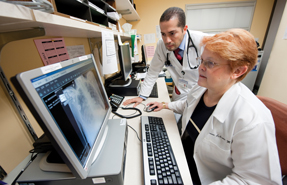Open access requires an open mind by doctors
Patients have always been able to review their records, but making this a routine practice has most patients enthused and some physicians worried. Learn how some large health systems are applying open access to improve patient communication and compliance.
There's a change coming, and it has some doctors worried, but many patients excited.
“The average general practitioner is absolutely terrified,” said Brian Fisher, MD, a primary care physician in London, England. “Their worries are manifold.” Meanwhile, Seattle patient Ken Dugan got an advance trial of the change and said, “I couldn't live without it.”

The funny thing is, the innovation that has these physicians and patients so fired up, patient access to medical records, is not even really new. Patients have long had the legal right to access their records upon request, and some practices, including Dr. Fisher's, have offered patients opportunities to review their files.
Recently, however, some large health systems have begun experimenting with using electronic health records to provide more convenient access for patients. In 2009, the University of Texas MD Anderson Cancer Center offered patients online access to their records, including doctors' notes, and a large pilot study of open access involving patients at Geisinger Health System in Pennsylvania, Beth Israel Deaconess Medical Center in Boston and Harborview Medical Center in Seattle just wrapped up.
That study, in which Mr. Dugan was a participant, also surveyed physicians and patients about their initial opinions regarding record access. Preintervention findings were reported in the Dec. 20, 2011 Annals of Internal Medicine and confirmed Dr. Fisher's and Mr. Dugan's observations that patients were more enthusiastic than physicians about the prospect of open access. (Final results of the pilot are expected to be published later in 2012.)
More than 90% of the 30,000-plus surveyed patients thought open records were a good idea, compared to 69% to 81% (depending on the study site) of the physicians who volunteered to have their records opened. Physicians at the same hospitals who didn't participate in the project took an even dimmer view of it; only 16% to 33% thought it was a good idea.
“They're concerned about whether this is a good idea for their patients: Is this going to affect their relationship with their patients? Is it going to confuse patients? Will it make patients worry?” said Jan Walker, RN, MBA, an instructor in medicine at Beth Israel Deaconess and lead author of the study.
“The second thing they are worried about is what this will do to their own workflow,” she continued. “Are patients going to bury me in questions on the phone and in e-mail?”
Dr. Fisher added some additional concerns to the list: “There's a worry that it will increase litigation. There's a worry that people will see things they shouldn't see.”
The risk that patients won't comprehend what they see is a common concern, according to Cheryl Craft, RN, coauthor of a study conducted at a Park Nicollet group practice in Minneapolis and published in the May 2011 Mayo Clinic Proceedings.
“Initially [physicians] thought that the patients wouldn't be able to understand the notes. They wrote the notes for themselves, not for patients to read. ... Mostly they just didn't see the need for it,” she said.
Some clinicians, however, do see a need for patients to have record access. “It could be a relatively simple way for patients to know more about their care and to be more engaged in their care,” said Ms. Walker. “It could also be a way for patients and providers to communicate better and understand each other better.”
How it works
To test these hypotheses, she and her colleagues set up the OpenNotes system at Beth Israel Deaconess, Geisinger and Harborview and recruited more than 100 primary care physicians who were willing to share their records with patients.
Patients could log in to the system at any time and were encouraged to do so whenever new information was available.
“They got an e-mail message telling them that a note was ready to read, and then before they had a subsequent visit, they got another message saying, ‘You have a visit coming up. You might want to review your last note,’” said Ms. Walker. Among other features, system users could also view their lab results and, at two of the three sites, send secure messages to their clinicians.
Since the one-year pilot just finished, the researchers don't have definitive conclusions about the effects of open access, but the anecdotal reports are positive. Only one physician quit the project.
“As a measure of success, having only one physician drop out of the program is very good sign,” said Jonathan Darer, MD, a study coauthor and chief innovation officer at Geisinger.
Comments from physicians during the study also indicated that their pre-pilot concerns were not being borne out.
“For the providers who participated, the overwhelming sentiment was, ‘I really don't think anything is happening. Are you sure you turned it on?’ The impact to most providers was negligible in terms of increased workflow or time spent in the office or even impact on the way they do their current work,” Dr. Darer said.
Those findings would come as no surprise to Dr. Fisher, who has been sharing records with patients for decades.
“About 30 years ago when I took my baby daughter to a general practitioner, they handed me her records while I was waiting for the doctor. It just struck me as such an amazingly simple idea,” he said.
Dr. Fisher copied the system in his own practice, and then in the 1990s, when he converted to an electronic records system, he provided patient access through a kiosk in the waiting room. The kiosk system alleviated concerns about Internet security and patient misunderstandings.
“If people saw things that they were frightened of, then they would be able to ask immediately,” he said.
But in practice, Dr. Fisher found that there was little need for this protection. “We realized after a while that it really was quite safe,” he said. “On the whole, they didn't really need to rush in to the doctor to get things explained to them.”
Patients' comfort with the system made physicians more accepting of it, too. “Once people give it a whirl, they realize the world doesn't fall apart,” Dr. Fisher said.
Measuring effects
Not only does the world remain intact, but it hardly even changes, according to the clinician researchers at Park Nicollet. Their multispecialty group practice offered open access to a group of patients seen in a rheumatology department in 2006 and then made comparisons with notes about those patients from before open access, as well as a concurrent group of patients seen in a pulmonary department who didn't have access.
They found only minimal differences in the content and language of the physicians' notes, contradicting their hypothesis that doctors would change what they wrote because a patient might be reading it.
“We were unable to find any evidence that physicians changed their dictations in any meaningful sense,” said Allan Kind, MD, an internist and study coauthor.
The researchers also investigated the issue of patient comprehension by providing patients with copies of their records and then asking them to discuss them.
“They don't seem to have any trouble interpreting a note. They appreciate that they don't get all of it, but they are quite comfortable looking at a physician's note and believing they understand the gist of it,” said Dr. Kind.
Despite these findings, Park Nicollet physicians have not been quick to change their opinions of open records. The researchers presented their results to the participating physicians and didn't get much response.
“I didn't see any of the physicians in the pulmonary group jumping on the bandwagon and saying, ‘We're going to go ahead with this,’” said Ms. Craft. “I don't think we've fully persuaded them that this was a good thing to do.”
To persuade physicians to give open records a try, most initiatives have built in some protections. Dr. Fisher's system allows physicians to block patients from seeing parts of the record. “It's actually possible for a practice to restrict patients' access to free text so patients only see the safe part of the data,” he said.
It also allowed physicians to start by providing access to just a few patients. “They can choose two or three to see what it's like, or just show it to their diabetic patients, or the patients who have lots of blood tests,” said Dr. Fisher.
The OpenNotes system granted participating patients complete access but gave physicians the option to exclude some of their patients from the program.
“The topics that always come up as possible special cases are substance abuse, mental health issues, cancer and obesity,” said Ms. Walker.
MD Anderson's system has dealt with some of the same areas of concern by not providing access to certain parts of the record, including social work, chaplaincy, psychiatry and neuropsychology. The system also delays reporting of certain information that designers thought was best conveyed and interpreted by physicians.
“There's a seven-day hold on diagnostic imaging, on laboratory results and on pathology results,” said Larry C. Driver, MD, a pain medicine specialist and chair of the hospital's medical records committee. Patient access to laboratory results has recently become a hot topic thanks to a proposed rule by the Centers for Medicare and Medicaid Services (see sidebar).
Patient interest
Even with these limits, MD Anderson's system has been popular with patients. In a sample week last year, more than 5,000 patients viewed their records, logging in about three times on average. “The growth has been phenomenal,” said Dr. Driver.
Not every patient necessarily wants to view their records, of course. Park Nicollet researchers found that about 20% “really have no interest” in doing it, Dr. Kind said. Another recent survey of more than 8,000 U.S. adults revealed even less excitement about the prospect of open records. About 60% of participants in a Cybercitizen Health U.S. 2011 study conducted by Manhattan Research had not accessed an electronic health record and didn't want to.
“There is a considerable population of people who just aren't that interested in their health data. I do think that doctors and nurses and other health care professionals are going to be the ones to explain the value proposition and help get their patients more engaged on an ongoing basis,” said Maureen Malloy, senior health care analyst for Manhattan Research.
Her interpretation was confirmed by Dr. Fisher's experience.
“There are some practices that promote the idea of record access very vigorously and they have significant proportions of patients who are using it. Other practices see it as not very important to the way they do business. In those practices, it's a very tiny proportion of patients,” he said.
He has observed some additional predictors of patient interest. “The people that use record access the most tend to be older and have long-term conditions, because those are the people who benefit most from having access to their records,” he said.
For example, Linda Johnson, a patient at Harborview in Seattle who participated in the OpenNotes study, used the system to see the results of her frequent lab work and to remind herself of her physician's instructions. “I don't have to go through hoops to find out what happened, or follow up if I forget a lab report or what I'm supposed to do,” she said.
The opportunity to review instructions was a major expected benefit of open records systems, noted Ms. Craft. Ms. Johnson's experience also confirmed another of the intended benefits: greater trust between physician and patient. “I have found that my doctor is very thorough. ... She's very methodical about getting the information entered in,” she said.
Dr. Fisher noted that open records also allow patients a chance to double-check information and note if physicians enter something incorrectly. “They can see things that aren't right and discuss it with the practice,” he said. “It makes care safer and it makes care more efficient.”
The systems are particularly efficient when patients are seen by physicians who don't have regular access to their records. “Our patients may not have money for a bus ride to get to our hospital. They go to 10, 15 different health care clinics and hospitals,” said Joann G. Elmore, MD, MPH, an internist at Harborview and coauthor of the Annals study. “If patients had access to their medical records, they could share them with physicians.”
Risks and challenges
Patients may also share their records with their family or other caregivers, which is both an advantage and a risk of the system. “There were some anecdotes about caregivers who would print out information for patients who could read it at their leisure,” said Dr. Darer.
The risk of such shared access is that privacy could be compromised. “A member of the family says, ‘What's your login? I'll see when your next appointment is.’ That person gets access to the record, gets access to everything,” said Dr. Driver.
Privacy is one of several issues that necessitates ongoing study during implementation of open access, noted Dr. Elmore. Another issue of continuing concern is language. When writing their notes, physicians might want to avoid certain words with negative connotations, like “disheveled.”
“There are some things that we've grown up in our medical training to use. I think that some physicians might be more careful and thoughtful in the use of subjective terms,” she said.
The Park Nicollet study found no significant changes in terminology, but in one anecdotal incident, a patient complained about her physician describing her as obese. Such issues are not too hard to fix, according to Dr. Driver.
“Instead of putting into the record that a patient is morbidly obese, they may just enter their body-mass index (BMI). BMI is a hard piece of data that communicates the same information,” he said.
It is challenges like these that motivate the gradual implementation of open access, experts said. “We have a lot of work left to do. It won't happen flicking on a switch and I think that's appropriate,” said Dr. Elmore.
But in the United Kingdom, the switch was effectively flipped on open access recently. “The U.K. treasury said that all National Health Service patients should have access to their primary care records by 2015. I would guess by 2020 this will be a normal part of life,” said Dr. Fisher.
There's no deadline for implementation in the U.S., but experts expect open access will soon be coming to a practice near you anyway.
“I think the patients really view this as being important and useful,” said Dr. Darer. “Once this technology becomes available, my sense is some patients will preferentially seek out physicians who are willing share this kind of information.”
Dr. Elmore agreed. “It's a question of not if, but when,” she said.




